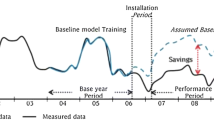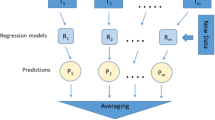Abstract
Building heating, ventilation, and air conditioning (HVAC) systems consume large amounts of energy, and precise energy prediction is necessary for developing various energy-efficiency strategies. Energy prediction using data-driven models has received increasing attention in recent years. Typically, two types of driven models are used for building energy prediction: sequential and parallel predictive models. The latter uses the historical energy of the target building as training data to predict future energy consumption. However, for newly built buildings or buildings without historical data records, the energy can be estimated using the parallel model, which employs the energy data of similar buildings as training data. The second predictive model is seldom studied because the model input feature is difficult to identify and collect. Herein, we propose a novel key-variable-based parallel HVAC energy predictive model. This model has informative input features (including meteorological data, occupancy activity, and key variables representing building and system characteristics) and a simple architecture. A general key-variable screening toolkit which was more versatile and flexible than present parametric analysis tools was developed to facilitate the selection of key variables for the parallel HVAC energy predictive model. A case study is conducted to screen the key variables of hotel buildings in eastern China, based on which a parallel chiller energy predictive model is trained and tested. The average cross-test error measured in terms of the coefficient of variation of the root mean square error (CV-RMSE) and normalized mean bias error (NMBE) of the parallel chiller energy predictive model is approximately 16% and 8.3%, which is acceptable for energy prediction without using historical energy data of the target building.
Similar content being viewed by others
References
Ahmad T, Chen H, Guo Y, et al. (2018). A comprehensive overview on the data driven and large scale based approaches for forecasting of building energy demand: A review. Energy and Buildings, 165: 301–320.
ASHRAE (2014). ASHRAE Guideline 14—Measurement of Energy, Demand, and Water Savings. Atlanta, USA: American Society of Heating, Refrigerating and Air-Conditioning Engineers.
Campolongo F, Cariboni J, Saltelli A (2007). An effective screening design for sensitivity analysis of large models. Environmental Modelling & Software, 22: 1509–1518.
Delgarm N, Sajadi B, Azarbad K, et al. (2018). Sensitivity analysis of building energy performance: A simulation-based approach using OFAT and variance-based sensitivity analysis methods. Journal of Building Engineering, 15: 181–193.
Douglas-Smith D, Iwanaga T, Croke BFW, et al. (2020). Certain trends in uncertainty and sensitivity analysis: An overview of software tools and techniques. Environmental Modelling & Software, 124: 104588.
EnergyPlus (2018). Engineering Reference. US Department of Energy.
Fan C, Sun Y, Xiao F, et al. (2020). Statistical investigations of transfer learning-based methodology for short-term building energy predictions. Applied Energy, 262: 114499.
Fan C, Chen M, Tang R, et al. (2022). A novel deep generative modeling-based data augmentation strategy for improving short-term building energy predictions. Building Simulation, 15: 197–211.
Heiselberg P, Brohus H, Hesselholt A, et al. (2009). Application of sensitivity analysis in design of sustainable buildings. Renewable Energy, 34: 2030–2036.
Helton JC, Davis FJ (2003). Latin hypercube sampling and the propagation of uncertainty in analyses of complex systems. Reliability Engineering & System Safety, 81: 23–69.
Higdon D, Kennedy M, Cavendish JC, et al. (2004). Combining field data and computer simulations for calibration and prediction. SIAM Journal on Scientific Computing, 26: 448–466.
Hong T, Buhl F, Haves P, et al. (2008). Comparing computer run time of building simulation programs. Building Simulation, 1: 210–213.
Hong T, Kim CJ, Jeong J, et al. (2016). Framework for approaching the minimum CV(RMSE) using energy simulation and optimization tool. Energy Procedia, 88: 265–270.
Hopfe CJ, Hensen JLM (2011). Uncertainty analysis in building performance simulation for design support. Energy and Buildings, 43: 2798–2805.
Hygh JS, DeCarolis JF, Hill DB, et al. (2012). Multivariate regression as an energy assessment tool in early building design. Building and Environment, 57: 165–175.
Lamagna M, Nastasi B, Groppi D, et al. (2020). Hourly energy profile determination technique from monthly energy bills. Building Simulation, 13: 1235–1248.
Li H, Wang S, Cheung H (2018). Sensitivity analysis of design parameters and optimal design for zero/low energy buildings in subtropical regions. Applied Energy, 228: 1280–1291.
Li A, Xiao F, Fan C, et al. (2021). Development of an ANN-based building energy model for information-poor buildings using transfer learning. Building Simulation, 14: 89–101.
Liu J, Chen X, Cao S, et al. (2019). Overview on hybrid solar photovoltaic-electrical energy storage technologies for power supply to buildings. Energy Conversion and Management, 187: 103–121.
Mechri HE, Capozzoli A, Corrado V (2010). USE of the ANOVA approach for sensitive building energy design. Applied Energy, 87: 3073–3083.
MOHURD (2014). JGJ62-2014. Design Standard for Hotel Buildings. Ministry of Housing and Urban—Rural Development of China (MOHURD). Beijing: China Architecture & Building Press. (in Chinese)
MOHURD (2015). GB 50189-2015. Design Standard for Energy Efficiency of Public Buildings. Ministry of Housing and Urban—Rural Development of China (MOHURD). Beijing: China Architecture & Building Press. (in Chinese)
Morrison Hershfield Limited (2016). Building Envelope Thermal Bridging Guide. BC Hydro Power Smart.
Pan Y, Zhang L (2020). Data-driven estimation of building energy consumption with multi-source heterogeneous data. Applied Energy, 268: 114965.
Pang Z, O’Neill Z, Li Y, et al. (2020). The role of sensitivity analysis in the building energy performance analysis: A critical review. Energy and Buildings, 209: 109659.
Pardalos PM (2009). Approximate dynamic programming: Solving the curses of dimensionality. Optimization Methods and Software, 24: 155.
Petersen S, Kristensen MH, Knudsen MD (2019). Prerequisites for reliable sensitivity analysis of a high fidelity building energy model. Energy and Buildings, 183: 1–16.
Saltelli A, Tarantola S, Campolongo F, et al. (2002). Sensitivity Analysis in Practice: A Guide to Assessing Scientific Models. Chichester, UK: John Wiley & Sons, Ltd.
Saltelli A, Ratto M, Andres T, et al. (2008). Global Sensitivity Analysis: The Primer. Chichester, UK: John Wiley & Sons, Ltd.
Saltelli A, Ratto M, Tarantola S, et al. (2012). Update 1 of: Sensitivity analysis for chemical models. Chemical Reviews, 112: PR1–PR21.
Savitzky A, Golay MJE (1964). Smoothing and differentiation of data by simplified least squares procedures. Analytical Chemistry, 36: 1627–1639.
Sha H, Xu P, Yang Z, et al. (2019). Overview of computational intelligence for building energy system design. Renewable and Sustainable Energy Reviews, 108: 76–90.
Sha H, Xu P, Lin M, et al. (2021). Development of a multi-granularity energy forecasting toolkit for demand response baseline calculation. Applied Energy, 289: 116652.
Spitz C, Mora L, Wurtz E, et al. (2012). Practical application of uncertainty analysis and sensitivity analysis on an experimental house. Energy and Buildings, 55: 459–470.
Tian W, Liu Y, Zuo J, et al. (2017). Building energy assessment based on a sequential sensitivity analysis approach. Procedia Engineering, 205: 1042–1048.
Tian W, de Wilde P, Li Z, et al. (2018). Uncertainty and sensitivity analysis of energy assessment for office buildings based on Dempster-Shafer theory. Energy Conversion and Management, 174: 705–718.
Zhao Y, Zhang C, Zhang Y, et al. (2020). A review of data mining technologies in building energy systems: Load prediction, pattern identification, fault detection and diagnosis. Energy and Built Environment, 1: 149–164.
Acknowledgements
This research is sponsored by China Southern Power Grid Technology Co. LTD (No. GDKJXM20200569).
Author information
Authors and Affiliations
Corresponding author
Rights and permissions
About this article
Cite this article
Sha, H., Xu, P., Yan, C. et al. Development of a key-variable-based parallel HVAC energy predictive model. Build. Simul. 15, 1193–1208 (2022). https://doi.org/10.1007/s12273-021-0885-0
Received:
Revised:
Accepted:
Published:
Issue Date:
DOI: https://doi.org/10.1007/s12273-021-0885-0




